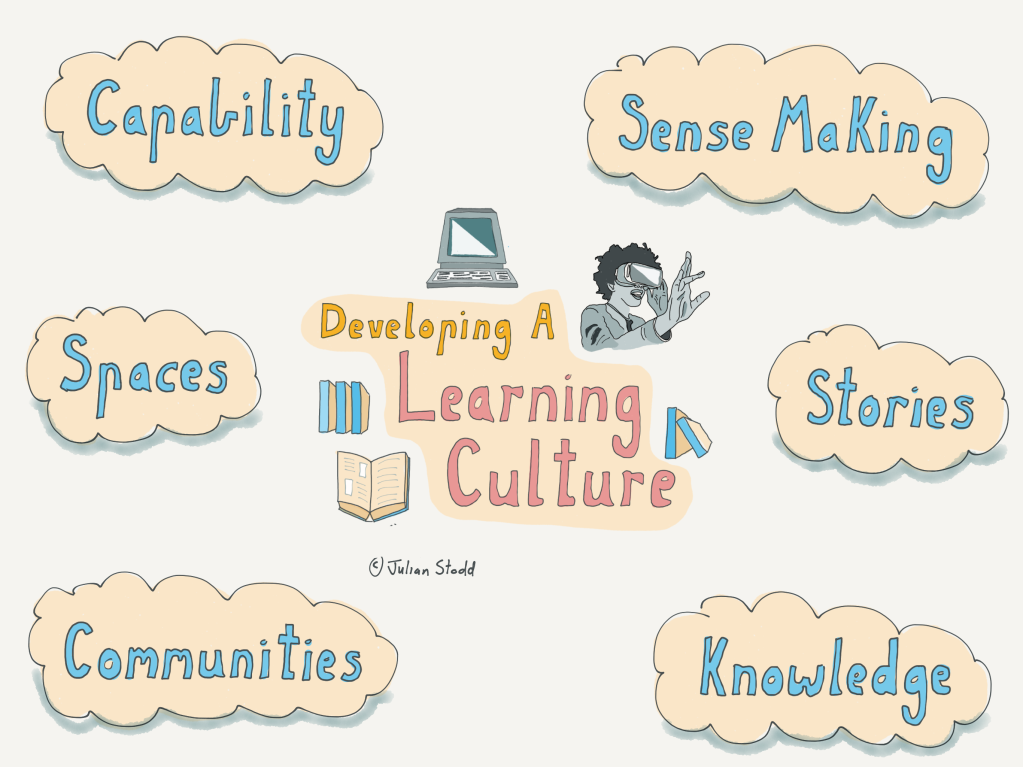I’m working on the high level design for a new programme on ‘Leading a Learning Culture’. It will be in six parts, and i’m sharing some fragments of it here. This is early stage work, but what i’m trying to do is to identify six aspects of culture which all require us to take a stance, understand mechanisms, or provide structure and support.

The six aspects are ‘Capability’, ‘Spaces’, ‘Communities’, ‘Knowledge’, ‘Sense Making’, and ‘Storytelling’.
Some, such as Capability and Knowledge are about broad shifts (the type of capability we need, beyond the skills economy, and the new nature of knowledge etc), things that we need to take a stance on. Others, like ‘Spaces’ and ‘Communities’ are about the structures that we learn within and, both formal and social, and the nuance within these – this relates to things we can build, understand, or influence. Finally, things like ‘Sense Making’ and ‘Storytelling’ are features of learning itself, but which can be channeled into a broader understanding of how people learn – they are things we can support and develop.
So the narrative would be something like this: if you lead learning within a contemporary Organisation, you need to consider the Capability that you hold and need, and the Spaces within which people learn, rehearse and perform. You need to look at the spectrum of Communities, to consider which you can build or support, and the ways that Knowledge is evolving, and how you access (or create) what you need. Finally, to consider how we support social Sense Making and the creation of diverse Stories of learning – this loops back to Capability, to consider the broader question of strength within systems, or beyond it.
[1] Capability – considering the type of capability we need, and the mechanisms of culture that will best support it.
- Structural and Social strength – system and process vs tacit and tribal
- Diverse Capability – codified vs diversified strength.
- The Porcelain Organisation – disruption, asymmetry and shock
- Resilience through interconnection – the fluid organisation, strength beyond systems
Organisations invest in learning in order to be more effective: that effectiveness may be held in new knowledge, in specific capability, in compliance, in wellbeing or innovation, in culture, in system and process, in leadership, in people, or in a host of other areas. But it is essentially about moving forward: taking what we already know and do, and somehow changing it to be better (and again, to be clear, ‘better’ means ‘more effective’).
[2] Spaces – exploring the layered spaces of culture, and how we navigate between them (and what we do in each of them!)
- Boundaries – permeability of ideas, diffusion across borders, cultural graffiti and permitted voice, edge-land spaces and the role of transience
- Power – ownership and control of space, relationships between space and power, types and control of consequence
- Performance culture – role of rehearsal space, learning space, fluidity of culture
[3] Communities – the social structure of learning culture, and how we build and support it
- Formal and Social Space – the rules, rituals and artefacts and imbued value, membership and belonging
- Coherence – purpose, values, lived experience, transmission, mechanisms of joining. Authenticity and the many flavours of ‘self’
- Consensus and constraint – dominant narratives, self moderation, expertise as constraint, ambiguity
- The Social Currencies – trust and pride, belief and fear, recognition and respect, marketplaces and control. Social badging
[4] Knowledge – the new nature of knowledge and the fitness of learning culture to support the creation of meaning
- Knowledge in practice – types of knowledge, dynamic co-creation, codification and distribution, power and control
- The creation of meaning – social collaboration, validation and control, sharing and trading
- Mechanisms of co-creation, tacit and tribal, contextualisation
- Social metacognition
[5] Sense Making
- Dialogue – difference and dissent, cultural health and width, learning as vocabulary, rapid prototyping, reflective surfaces, metacognition
- As process – gateways and spaces, assessment of the journey, social badging
- Identity – certainty, reputation, the many selves
[6] Storytelling – layers of story and the ‘organisation as entity of story and belief’
- Layers of narrative – the personal, co-created and formal, tension and friction, creative dissent, self and system
- Trapped in stories – existing knowledge, fracture and fragmentation in learning, role of curiosity, disturbance, learning as mosaic, scrap learning
This is early stage #WorkingOutLoud on Learning Culture and the leadership needed to build it.


